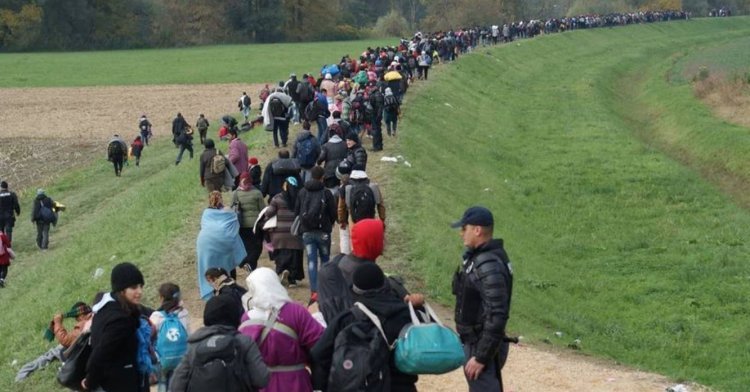“Let’s stop this hypocrisy (…) we are facing an invasion, organised by Turkey.” On the 3rd of March, Yannis Pretenderis, a Greek writer, reacted strongly to Turkish President Recep Tayyip Erdoğan’s decision to open borders to refugees. At the centre of these discussions and actions are individuals tossed back and forth, fleeing for their lives and dreaming of a better life, far from the violence and daily atrocities they have had to endure in their countries of origin.
And while debates are raging and political decisions with major consequences are being taken, hundreds of thousands of people sometimes face extreme instability, even after having left their country behind for various reasons.
Who are the migrants?
The issue of migration often suffers from a lack of clarity. People leaving their country and arriving in another are described in different ways. There is a real semantic opposition between the terms ‘migrant’ and ‘refugee’. As Le Monde reminded us in 2015, in international law, a ‘refugee’ is the official status of a person who has been granted asylum in a third country. It is defined by the Geneva Convention signed in 1951.
“…the status of refugee being accorded to persons who [have] (…) well-founded fear of being persecuted for reasons of race, religion, nationality, membership of a particular social group or political opinion, is outside the country of his nationality and is unable or, owing to such fear, is unwilling to avail himself of the protection of that country; or who, not having a nationality and being outside the country of his former habitual residence as a result of such events, is unable or, owing to such fear, is unwilling to return to it.”
Though there is no legally recognised definition of the term ‘migrant’, it is used by UNESCO to mean “any person who lives temporarily or permanently in a country where he or she was not born, and has acquired some significant social ties to this country”. All refugees can therefore be migrants, but not the other way around. Migration can have very different causes: war, economic motives, environmental reasons, work or family.
The flow of asylum seekers on the other hand is closely linked to ongoing conflict. Following the wars in Syria and Libya, their presence in Europe increased. Since 2010, the EU has recorded an average of almost 700,000 asylum requests per year, with significant variations: in 2015 and 2016, the number exceeded one million, before reducing again to less than 800,000 in 2017. Back in 1994, asylum requests skyrocketed in Europe as fighting raged in ex-Yugoslavia.
A major political argument
Migrants’ place in public discourse and in the news seems, nevertheless, contrary to their real importance in the European population. The number of non-European citizens residing in an EU member state on the 1st January 2019 was 21.7 million, or 4.9% of the population of the 27 member states. A situation that is unlike that of Lebanon, where half of the work force is said to be made up of Syrian migrants, and which welcomes hundreds of thousands of Palestinian refugees (around 470,000 in 2019).
Furthermore, a significant part of migration concerning the European Union is internal migration, taking place between its member-states. Thus, out of the 4.4 million immigrants received by the EU in 2017, “it is estimated that 1.3 million people had the nationality of a member state other than the one to which they had immigrated”, according to Eurostat.
Nonetheless, the perception of mass immigration is a theme that has successfully returned to general and European elections. “Immigration is the origin of all problems”, declared German minister of the Interior Horst Seehofer in September 2018 reviving discussions on the subject among his country’s political élite.
In the European Parliament, the issue is also very much on the agenda. “The right to control and regulate immigration is therefore a fundamental principle shared by the party members”, Identity and Democracy claims among its main commitments. The political group is currently the fourth largest in the European Parliament, ahead of the Greens-EFA group.
The legal basis for European immigration policy is set out in Articles 79 and 80 of the Treaty on the Functioning of the European Union.
A long and harrowing journey
Beware: while we are contextualising the numerical and proportional significance of migrants from outside Europe, this does not mean we are discounting the dangerousness of their journeys.
The first risk factor: the length of the journey. While Syrians “only” have to cross Turkey to reach EU borders (which is in itself very dangerous, especially following the agreement that Turkey made with the EU in 2016), migrants from sub-Saharan Africa and Afghanistan have to travel several thousand kilometres. The former generally leave either from West Africa via Bamako and Gao in Mali or Niamey and Agadez in Niger, or from East Africa via Addis Ababa in Ethiopia or Khartoum in Sudan. Crossing the Sahara is extremely harrowing, and the risk of enslavement cannot be excluded. In November 2017, a report by the American television channel CNN shocked the international community with video footage of thousands of African migrants reduced to slavery in Libya.
The second risk factor: the age of the migrants. Children are particularly vulnerable, because according to UNICEF (the United Nations’ International Children’s Emergency Fund) nearly 3 in 4 children experience violence and abuse during their journey. In Lesbos, “the first to drown are the children”, wrote a journalist from the Italian daily newspaper La Repubblica on the 29th February. And of the 20,000 people living in the Moria camp, 7,000 are children. The situation was not much better before 2016, when the route through the Balkans was in frequent use. The refugees - men, women and children- had to cross barbed-wire fences as well as endure tear gas and stun grenades “thrown by the Balkan forces of law and order.”
Thus, refugees have to undertake an extremely harrowing journey lasting several months, or even several years, with a totally uncertain outcome. The Mediterranean Sea is indeed the world’s first refugee cemetery with hundreds of makeshift boats sinking in its waters every year. This prompted the former President of the Italian Council [of Ministers], Enrico Letta, to say the following at a conference at the Sorbonne on the migration crisis and the European elections: “If in a hundred years a marine biologist explored the Mediterranean seabed and found the skeletons of over 15,000 people, he would wonder what atrocious war took place between 2014 and 2019.” [English translation source].
Human before anything else!
What emerges most often from media reports and analyses is the economic effect of the refugee crisis. They often describe a flow of migrants (the way one might describe a flow of capital, or a flow of goods), and do not hesitate to add that these refugees are “packed into refugee camps” (a bit like cattle).
“What have we done to make the world treat us this way? What crime have we committed to be put to such torment? ", laments Syrian journalist Dalir Youssef, in an article translated by the Courrier International. Refugees are men and women like anyone else, they have just never had the chance to have the material standard of living comparable to ours in Europe. Or indeed if they did, war and persecution have put an end to their peaceful lives.
Let it be said: the migrant crisis of the mid-part of the last decade will be nothing in comparison to the forced migration of hundreds of millions of people driven from their countries by the unfolding effects of climate change. If the EU failed to properly manage the arrival of a few hundred thousand people in 2015 and 2016, how can it possibly survive another unprecedented wave of migration, within less than a generation?
In the current context of the pandemic, migrants are also victims. The Spanish newspaper El País reported on the two-fold vulnerability of migrant workers around the world in the face of the epidemic and the consequences of lockdown. Portugal has taken action by awarding citizenship to all immigrants who applied before the country entered its current state of emergency on 18th March. These immigrants can now exercise the same rights as Portuguese citizens, both in terms of health and financial aid.
However, authorities in France are continuing to expel migrants from Ventimiglia on the Franco-Italian border reports Il Fatto Quotidiano. In a complex situation and locked outdoors, migrants should not simply be the object of dehumanising discourse and haggling between states, as Le Monde points out.
Once again, they are humans before anything else.




Follow the comments: |
|
